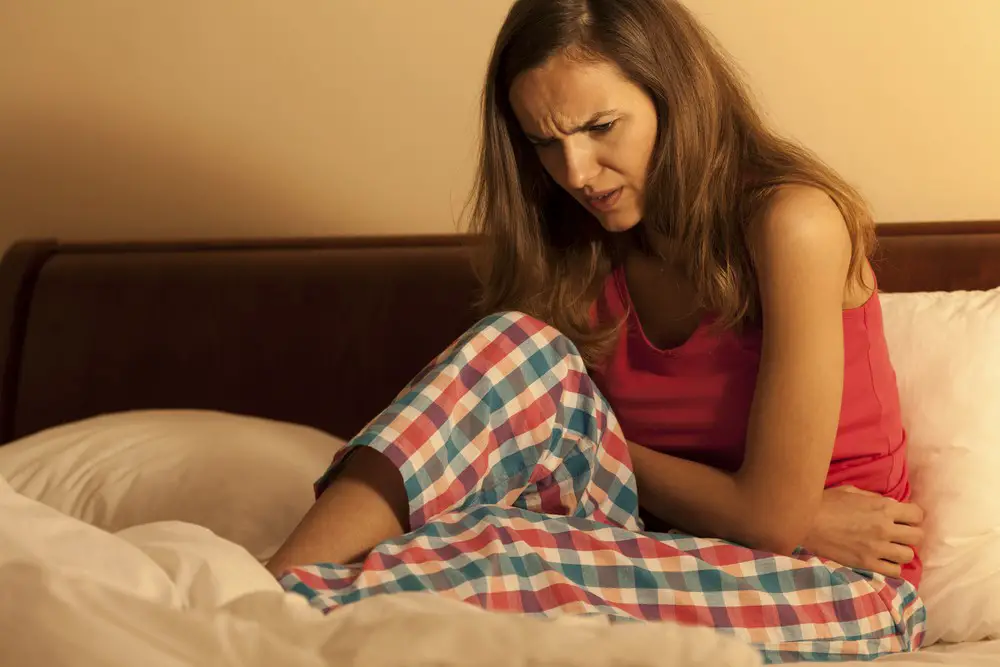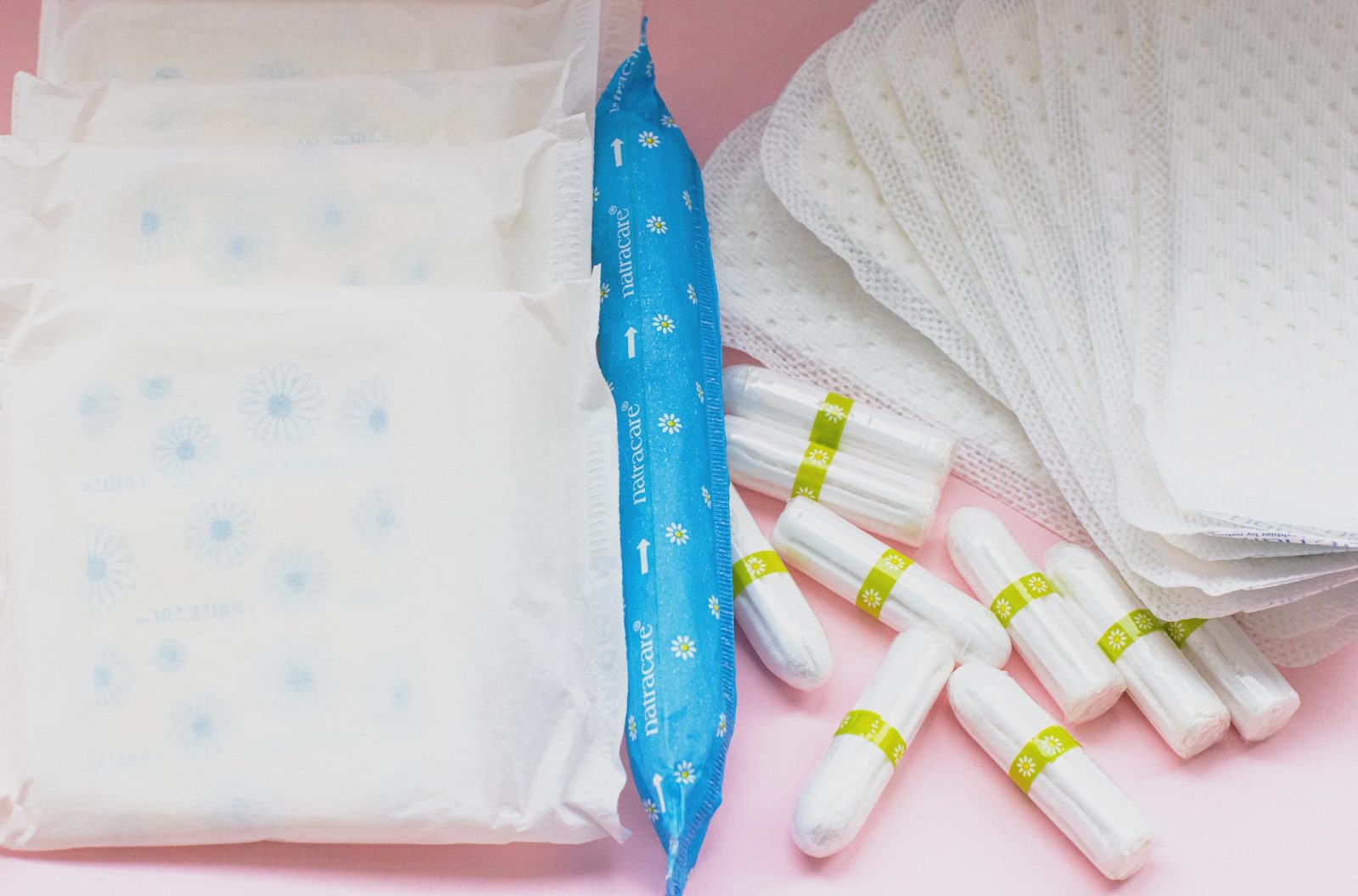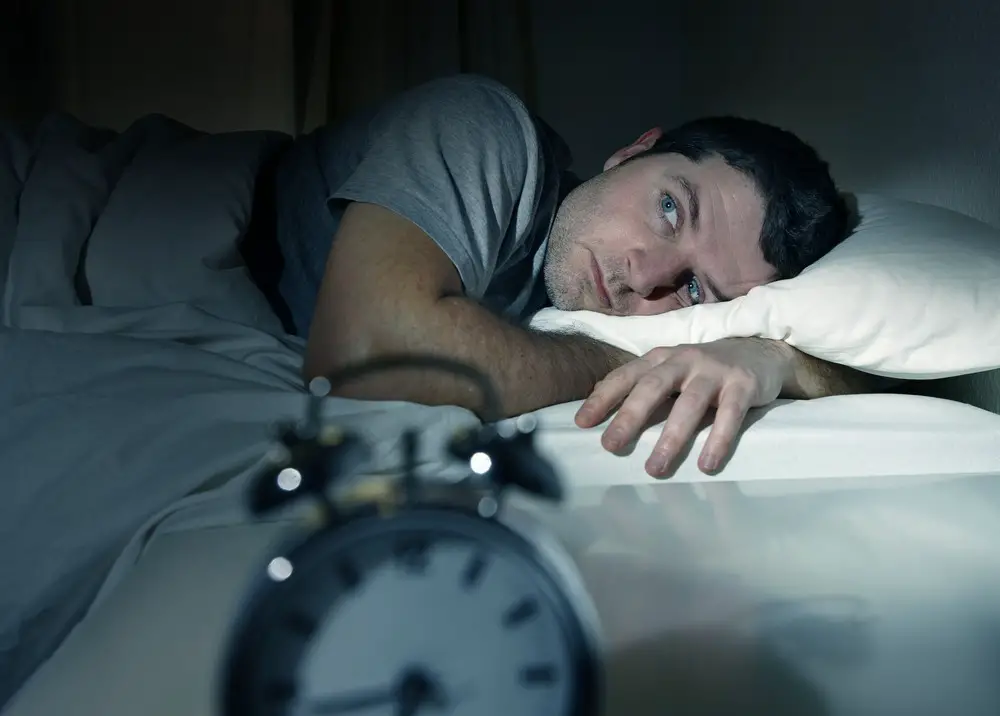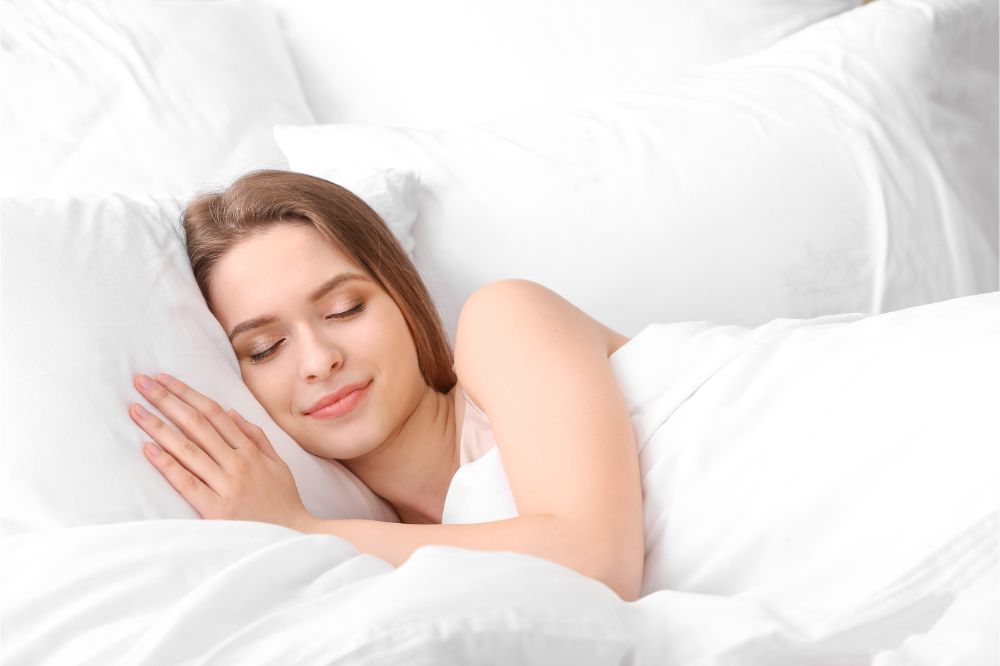As a BetterHelp affiliate, we receive compensation from BetterHelp if you purchase products or services through the links provided
Sleeping during menstruation can be challenging for many people, as the fear of stains and discomfort caused by cramps may lead to restless nights. Ensuring a good night’s sleep during periods is crucial for maintaining overall health and well-being. This article will explore various methods and products that can help individuals sleep comfortably and prevent stains during their menstrual cycle.
Understanding the menstrual cycle and how it affects sleep is essential in finding the right solutions for period-related sleep issues. Thus, we will discuss the impact of hormones on sleep, the benefits of different period products for better sleep, and comfortable sleeping positions to minimize the risk of leaks. The article will also cover hygiene, infection prevention, and tips for managing menstruation symptoms that can affect sleep.
Key Takeaways
- Adopt suitable period products and sleeping positions to minimize leaks
- Prioritize hygiene and infection prevention for comfortable sleep
- Consider medical interventions if menstrual symptoms severely affect sleep quality
 Understanding the Menstrual Cycle
Understanding the Menstrual Cycle
The menstrual cycle is a natural process experienced by individuals with female reproductive systems. It involves a series of changes in the body, regulated by hormones such as estrogen and progesterone. These hormones are crucial in controlling the menstrual cycle and its associated symptoms.
Each cycle typically lasts for 28 days, although the length can vary from person to person. The menstrual cycle can be divided into three phases: the follicular phase, the ovulatory phase, and the luteal phase. The follicular phase begins with the first day of menstruation, during which the uterine lining is shed. This phase continues until ovulation occurs when the ovary releases an egg.
Ovulation marks the start of the ovulatory phase, where the egg travels through the fallopian tube, awaiting fertilization. If fertilization does not occur, hormone levels gradually decline, leading to the onset of the luteal phase. During this phase, the body prepares itself for the possibility of pregnancy by thickening the uterine lining. However, if pregnancy does not occur, the lining is shed once again, marking the beginning of the next menstrual cycle.
Menstrual symptoms are common and can include both physical and emotional changes. Physical symptoms often range from mild discomfort to severe pain, including cramping, bloating, and fatigue. Emotional symptoms may involve mood swings, irritability, and feelings of depression or anxiety. These changes are typically attributed to fluctuations in hormone levels throughout the menstrual cycle.
Premenstrual symptoms, or PMS, occur one to two weeks before menstruation. PMS is primarily caused by the drop in estrogen and progesterone levels that precede menstruation. Some individuals experience a more severe form of PMS, known as premenstrual dysphoric disorder (PMDD), characterized by extreme mood swings and significant disruption to daily functioning.
To better manage sleep and minimize staining during menstruation, it is essential to understand the different phases of the menstrual cycle, hormonal fluctuations, and their impacts on an individual’s body and emotions. By staying informed and aware of these changes, one can proactively adjust sleep positions and hygiene practices to ensure a more comfortable and restorative night’s sleep.
Sleep and Menstruation
During menstruation, it’s essential to maintain good sleep quality to support overall well-being. Many individuals experience trouble sleeping, excessive sleepiness, and changes in body temperature, which can affect their sleep cycle. Consider the following tips to avoid stains while getting better sleep during periods.
Establishing a consistent sleep schedule is vital for improved sleep quality. Going to bed and waking up simultaneously each day helps regulate the body’s internal clock, making it easier to fall asleep and wake up refreshed.
Proper bedding and sleepwear choices can help avoid stains while providing a comfortable sleep environment. Opt for dark-colored bed sheets and use a mattress protector, which can be easily removed and washed. Additionally, wearing menstrual-specific sleepwear or using a cup instead of traditional pads and tampons can help minimize leakage.
For a more comfortable sleeping posture, lying on the side with a pillow between the legs can aid in reducing pressure on the pelvic area and provide better sleep during periods. This position lessens the chances of stains and supports proper spinal alignment, contributing to deep sleep.
To regulate body temperature during sleep, maintain a cooler room temperature and use lightweight and breathable fabrics for bedding and sleepwear. Elevated body temperatures can disrupt sleep, so keeping the room cool and comfortable is key.
Implementing relaxation techniques, such as gentle yoga or deep breathing exercises, can help alleviate menstrual discomfort, leading to better quality sleep. Integrating these practices into your nighttime routine can calm the mind and prepare the body for rest.
Moreover, avoiding caffeine, nicotine, and other stimulants close to bedtime can improve sleep quality during menstruation. Stimulants can cause restlessness and make it harder to fall asleep, so opt for decaffeinated or herbal options instead.
By following these suggestions, individuals can enhance their sleep experience and minimize the risk of stains during menstruation, leading to more restful nights and better overall health.
 Managing Period Leaks at Night
Managing Period Leaks at Night
Many struggle with period leaks at night, resulting in stained sheets and discomfort. To prevent period leakage at night, consider implementing strategies to keep you secure and comfortable while sleeping.
One recommended method is using overnight pads. These pads are designed specifically for nighttime use, with higher absorbency and a longer length than regular pads. This protects against leakage, especially when sleeping in positions that exacerbate the risk of leaks.
Leakproof underwear is another excellent option for managing period leakage at night. This type of underwear is designed with a built-in absorbent layer that can hold fluid and prevent it from seeping through. Worn alone or paired with overnight pads, leakproof underwear can provide additional protection and security.
When selecting pads, choosing ones with wings – flaps on the sides of the pad that fold over the edges of your underwear is beneficial. Wings help keep the pad in place and provide extra coverage to reduce side leaks. Regular pads with wings can also be combined with leakproof underwear for a more comprehensive approach to managing leaks.
Finally, consider combining absorbency period products to address your unique needs. This may include experimenting with various brands, styles, and absorbency levels of pads, tampons, and menstrual cups or using multiple products simultaneously for added protection. By tailoring your approach to your body’s requirements, you can ensure a more secure and restful night’s sleep during your period.
 Period Products for Better Sleep
Period Products for Better Sleep
Choosing the right period product can significantly improve sleep quality and reduce the risk of stains during menstruation. The variety of available products ensures a suitable option for everyone.
Pads are a popular choice, especially for nighttime use. Maxi pads have higher absorbency and offer excellent protection against leakage, ideal for overnight protection. Cloth pads are a reusable alternative to disposable pads, which can be more environmentally friendly and cost-effective. Organic cotton pads are a good option for sensitive skin, as they are made from natural materials and contain no bleach or dyes.
Menstrual cups are another suitable alternative for sleeping. These eco-friendly, reusable silicone or rubber cups collect menstrual fluid instead of absorbing it. They can be worn for up to 12 hours, offering reliable protection throughout the night. This option can also be less irritating for sensitive skin.
Tampons provide internal protection and can be effective for sleeping, especially when used with a pad or period underwear. Changing the tampon before bedtime and upon waking up will help prevent leakage and ensure a comfortable night’s sleep.
Period underwear is designed to absorb menstrual fluid without additional products. These washable, reusable garments are made from layers of absorbent fabric and can provide peace of mind during sleep. Wearing period underwear on heavier days or as backup protection with other menstrual products offers added security.
In conclusion, finding the most suitable period product for better sleep will vary based on individual preferences, comfort, and flow. Choices ranging from pads and tampons to menstrual cups and period underwear provide numerous options to create a stain-free and relaxed sleeping experience during periods.
Comfortable Sleeping Positions
Finding the right sleeping position during periods can significantly reduce the risk of stains and provide a comfortable night’s sleep. While individual preferences may vary, there are some widely favored positions for better sleep and stain prevention.
Sleeping on your back is popular as it reduces pressure on the abdominal muscles and uterus. This position also allows gravity to work in favor and minimize leakages. Add a pillow under the knees to help maintain the spine’s natural curve to enhance comfort. Additionally, using a protective mattress cover or placing a towel underneath can serve as extra protection against potential stains.
Another effective sleeping position is the fetal position, where one lies on the side with knees bent and pulled up towards the chest. This position can alleviate cramps by relaxing the abdominal muscles and taking pressure off the uterus. Sleeping in the fetal position also narrows the vaginal opening, making it harder for menstrual blood to leak. Place a pillow between the knees to align the hips and spine for extra support, promoting comfort and reducing strain on the lower back.
Experimenting with various sleeping positions and supportive pillows can help individuals discover the optimal way to sleep during their periods comfortably. By taking these precautions and adopting suitable positioning, uninterrupted sleep and reduced risk of staining can be achieved throughout the menstrual cycle.
Hygiene and Infection Prevention
Maintaining proper hygiene during periods is crucial to avoid stains and prevent infections. Changing underwear frequently, especially when it becomes damp or stained with menstrual blood, can minimize the risk of bacterial growth. Opt for breathable, moisture-wicking fabrics like cotton to reduce the chances of blood stains.
Maintaining a balanced pH is essential to keep the vaginal area clean. Remember that period blood can alter the natural pH levels of the vagina, making it more susceptible to infections. Use a mild soap when washing the area; pH-balanced and free of harsh chemicals and scents is best. Soaps gently cleanse without disrupting the delicate balance of good and bad bacteria.
In addition to frequent underwear changes and gentle cleansing, consider the following best practices:
- Use menstrual products according to their recommended usage times. Change pads and tampons every four to eight hours, depending on the flow.
- Avoid using scented or heavily fragranced menstrual products, as these can irritate the sensitive vaginal area.
- Choose pads with wings or longer designs to minimize contact between menstrual blood and the vaginal opening.
- Practice good hand hygiene before and after changing menstrual products to prevent the spread of bacteria.
Adhering to these hygiene tips can effectively reduce the chances of infections and staining during periods, ensuring a more comfortable experience.
Managing Menstruation Symptoms for Better Sleep
Dealing with menstruation symptoms during the night can be challenging. Incorporating techniques like yoga, exercise, meditation, and deep breathing can greatly improve sleep quality and help avoid stains.
Yoga improves blood circulation, effectively reducing painful cramps and other PMS symptoms like bloating and fatigue. Exercise, in general, can also alleviate headaches and other discomforts by releasing endorphins.
Meditation and deep breathing exercises contribute to a calm and relaxed mind, addressing mood swings, anger, stress, and premenstrual dysphoric disorder (PMDD) symptoms. Listening to calming music as a bedtime routine can further support relaxation and improve sleep quality.
Paying attention to diet is crucial during menstruation. Consuming foods rich in vitamins and minerals like magnesium and B6 can help soothe Pre-Menstrual Syndrome (PMS) symptoms. Additionally, reducing caffeine, alcohol, and salt can reduce bloating and related discomforts.
Supplementing the diet with natural remedies like chaste berry, ginger, or evening primrose oil can relieve various period-related symptoms and improve sleep by reducing pain, mood swings, and irritability.
Incorporating these practices into a daily routine can help manage menstruation symptoms effectively, allowing for a better night’s sleep and reduced chances of stains. Remember, it is essential to identify which techniques and remedies work best for each individual’s unique needs and make necessary adjustments.
Preventing Stains and Planning
Preventing stains during periods is a concern many individuals face. One effective way to avoid staining is by placing a dark towel on the bed while sleeping. This can help absorb any leaks, and the dark color will help make any stains less visible.
Another important measure is to ensure you go to bed wearing a fresh pad, tampon, or menstrual cup. This reduces the chances of leaks overnight. Before sleeping, consider gently rinsing the area with water and a bar of mild soap. Additionally, for those who prefer swimming during their periods, using a tampon or menstrual cup can greatly reduce the risk of leaks.
Incorporating some simple planning strategies can also go a long way in preventing stains. Period tracker apps, for example, can help track the cycle and predict the next period’s start date. This allows individuals to be prepared and use the necessary products before staining occurs.
With a routine in place, one might consider adjusting the products’ absorbency according to the flow. For instance, using a higher-absorbency pad or tampon on heavy flow days can provide extra protection. It’s also crucial to change the product regularly, as suggested by the manufacturer, to minimize the risk of leaks.
Lastly, promptly washing any stained clothes or linens can help remove stains more effectively. Using cold water and a bit of mild detergent or salt can be beneficial in eliminating period stains and keeping everything fresh and clean.
Considering Medical Intervention
If other methods for avoiding stains during periods prove insufficient, medical intervention may be an option to explore. One approach is oral contraceptives, which can help regulate the menstrual cycle and potentially decrease the flow.
Oral contraceptives contain hormones, such as progestin and estrogen, that prevent ovulation. This can lead to fewer and lighter periods for certain individuals. Consequently, this may reduce the chances of staining while sleeping.
However, it is important to note that oral contraceptives may not be suitable for everyone. Consult a healthcare provider before considering this option. They will assess the individual’s medical history, current medications, and other factors to determine if oral contraceptives are appropriate and safe.
Sometimes, a physician may also recommend alternative medications or treatments tailored to address specific issues related to heavy bleeding and staining. It is important to openly discuss concerns about staining during sleep with a healthcare professional, as they can provide personalized guidance on suitable interventions.
Remember, incorporating medical intervention may take time to show results, and each person’s experience may vary. Always communicate with a healthcare provider to ensure proper monitoring and adjustments to any treatment plan.
Frequently Asked Questions
How to prevent leakage during sleep on your period?
Choose the right menstrual product for your flow to prevent leakage during sleep. Opt for pads with wings, tampons, or menstrual cups that offer good coverage. Change your menstrual products right before bed to ensure maximum absorbency. You can also use a waterproof mattress protector or dark-colored sheets to minimize the impact of any leaks.
Best sleep position to minimize stains?
Sleeping in the fetal position can help minimize stains, as it keeps your legs together and reduces the chances of leakage. You can also try sleeping on your back with a pillow under your knees to maintain a slight elevation and limit the risk of staining.
Why does leakage occur more at night?
Leakage can occur more at night because, when you lie down, gravity may cause the menstrual flow to move more toward the back area of your body, increasing the chance of leaks. Additionally, during sleep, you may be unable to shift positions or change your menstrual products as frequently as you would during the day.
How to sleep without a pad on your period?
If you prefer not to use pads while sleeping, you can opt for alternatives like tampons or menstrual cups. Both options can offer reliable leakage protection, depending on your flow and how well they are inserted. Follow proper insertion techniques and choose the right size or absorbency for your needs.
How can I sleep comfortably and stain-free?
To sleep comfortably and stain-free, ensure that your bed is well-prepared for your period. A waterproof mattress protector or dark-colored sheets can help minimize the appearance of any stains. Also, wear a comfortable pair of period panties or pajama pants. Staying warm and relaxed during sleep can also contribute to a more comfortable night’s rest.
Are there tips to avoid period gushes while sleeping?
To avoid period gushes while sleeping, change your menstrual products frequently and right before bedtime. Pay attention to your menstrual flow, and choose a product with enough absorbency to handle it. Maintain good sleeping posture and avoid positions that may cause more leakage. Relaxed and deep breathing techniques might assist in reducing sudden gushes during sleep.
- 3 Ways Wearing a Hat Can Help Lower Your Stress Levels - April 19, 2025
- Breaking the Silence: Why Men’s Mental Health Matters More Than Ever - April 15, 2025
- How to Transform a Home’s Patio Space into a Relaxing Space - March 23, 2025
This site contains affiliate links to products. We will receive a commission for purchases made through these links.


 Understanding the Menstrual Cycle
Understanding the Menstrual Cycle Managing Period Leaks at Night
Managing Period Leaks at Night Period Products for Better Sleep
Period Products for Better Sleep
